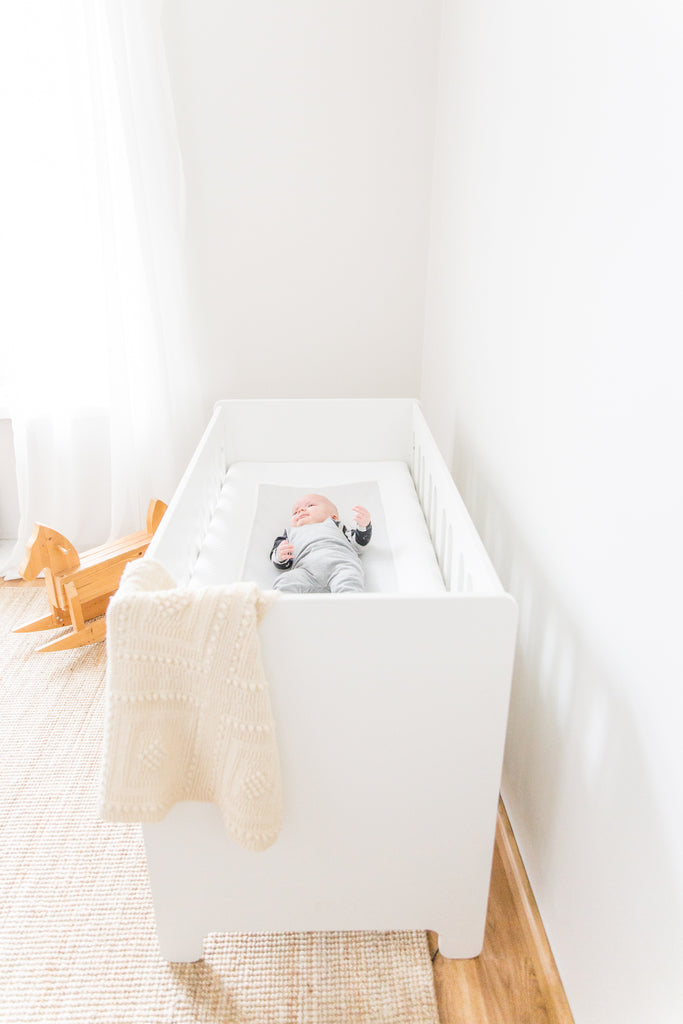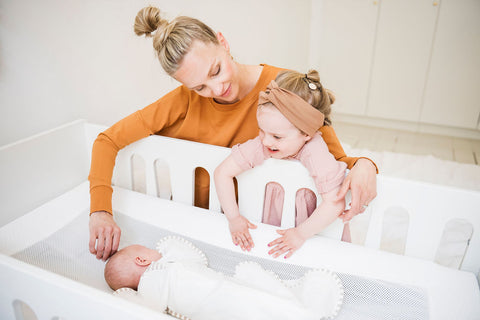The time when your child is a baby can be wonderful and carefree, but challenges with sleeping can cast a shadow on even the happiest everyday life. The sleeping rhythms and habits of babies vary greatly, depending on their natural temperament, for example. However, parents can support the sleep of their baby and promote the coping of the entire family using some significant methods.
Newborn babies sleep a lot but often for short periods at a time. They develop quickly and learn new things and develop their sleeping rhythms every day. Even if the baby’s sleeping rhythm begins to even out around the age of six months, you can gradually begin to steer their rhythm towards the right direction from day one.
We listed our three favourite tips for supporting the development of your baby’s sleeping. LullaMe Solina is developed to support the parents and baby in finding a good sleeping rhythm, and combined with these tips, for example, we can say from experience that everyone has a possibility to sleep better. Try out the tips suitable for your family, and start your journey towards sleeping better!
Tip 1: The baby’s daily rhythm
A clear daily rhythm helps the baby to understand the difference between night and day. The daily rhythm aims to help the baby to recognise the times of the day and react in a way suitable for the time. The actions and behaviour of the parents steer the baby, who will learn by following the example set by the parents. Finding the difference will teach your baby to sleep for the longest period in nighttime and be more active during the day, for example.
In practice, parents can emphasise the difference in many ways, for example doing things actively and briskly in daytime, and more calmly and plainly in the nighttime. The difference can also be emphasised using differences in the amount of light, volume of voice, and amount of interaction. The parents should pay particular attention to ensuring a sufficient amount of closeness and interaction for the baby during the day to ensure that they are satisfied with less interaction during the night.
‘Our nights have been a bit less peaceful since the age of 4 months, and I feel that the mattress has helped with them. When our boy starts babbling at night, all I need to do is give him his pacifier and say ‘go to sleep,’ turn on the rocking motion, and leave the room, and he has calmed down and the mattress has helped him fall asleep again.’
Feedback on Instagram from @sosssi
Tip 2: Having the baby fall asleep independently
You can encourage your baby to fall asleep by themselves from the age of 1–3 months. The primary thing for your baby to be able to fall asleep by themselves is the experience of safety. You should let your baby know that it is safe to fall asleep in their own bed. The rocking motion of the LullaMe Solina will remind your baby of their time in the womb, relax them, and increase their feeling of safety. The gentle motion will also make the baby more sleepy and help them fall asleep when going to sleep and between sleep cycles.
Eating in the evening is one of the significant times you should consider when teaching your baby to fall asleep independently. Have your baby eat in a dimly-lit and calm space, but keep them awake during eating. However, if your baby falls asleep on your breast or by the bottle, you can stir them through burping them, for example, before placing them on the bed. In order to increase the baby’s feeling of safety, they should be able to wake up where they fell asleep.
‘The role of the [LullaMe Solina] mattress has been significant in some particular situations. For example, Daniel usually falls asleep on my breast after eating in the evening. When I move him to his bed, I soon notice his eyes are open and he is laughing at my attempts to put him to bed without waking him up. When I place Daniel on the mattress, give him his pacifier, and turn on the rocking motion from the remote control, he is soon fast asleep.’
- Saija & baby Daniel, the Saijis blog
Tip 3: The baby’s evening routines
Familiar and repeated evening routines will increase your baby’s feeling of safety. They will learn the predictable and repeated habits, and know what will happen next. Evening routines also play a part in establishing the baby’s daily rhythm, because they function as a clear transition between day and night. They should be made into a pleasant time together, ending the fast-paced day calmly.
Read more: The sleep of a baby is different from the sleep of an adult
The routines do not need to be complex rituals, and every family can choose which repeated evening activities suit them the best. For a newborn baby, simply changing their diaper in the same place and in the same order every evening and putting on their nightclothes is a sufficient routine. For older babies, a lullaby, a small massage, or another small moment of closeness can also be a pleasant part of the evening routine. It is essential for you to commit to the routines so that your baby will soon learn to recognise the pattern.
‘At the moment, he [baby Eemi] sleeps 3–5 hours at a time almost every night, followed by some periods of two hours, after which we get up. At first, I rocked him to sleep in my arms and placed him on his bed, but now he has begun to fall asleep by himself.
I put him into his nightclothes, swaddle him up tight, and place him in his bed with white noise music and a belly full of milk. This way, I get at least four hours of really good sleep every night. It sure feels great. Of course there are exceptions, but as a main rule.’
- Iida & baby Eemi, the Iidan matkassa blog
Every baby's sleeping rhythm is individual and will reach their own sleeping rhythm at the time suitable for them. However, supporting their natural inclinations and steering them towards the desired direction is good, because even the smallest steps forward count when talking about the coping of the entire family. LullaMe Solina supports families in building a sound sleeping rhythm, which often has positive effects years afterwards. We wanted to make trying out the LullaMe Solina sleeping solution as simple as possible, which is why we also offer a 30-day trial for our product. Read more about the trial here.
LullaMe wishes beautiful dreams and happy days to all families with babies!





Leave a comment: